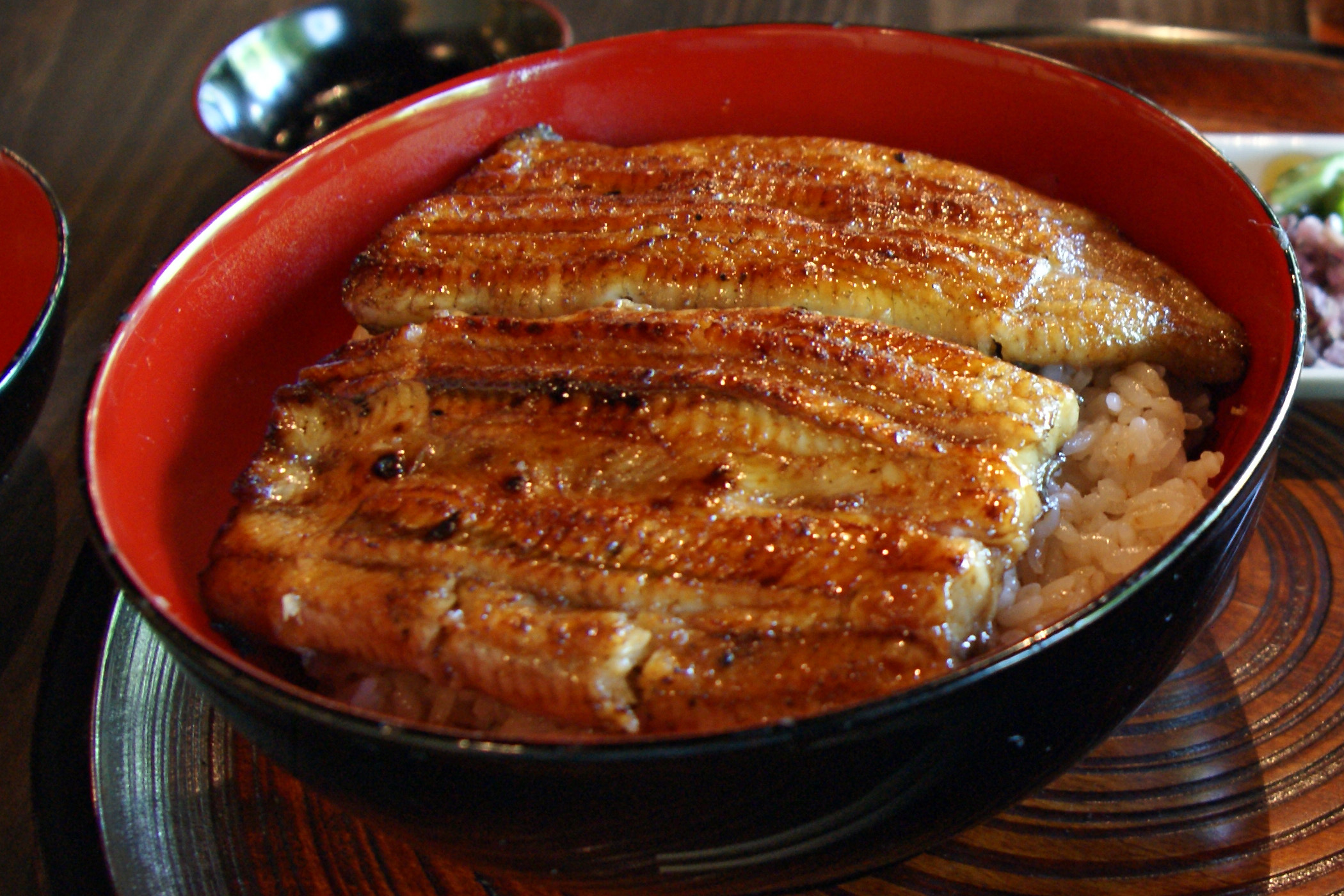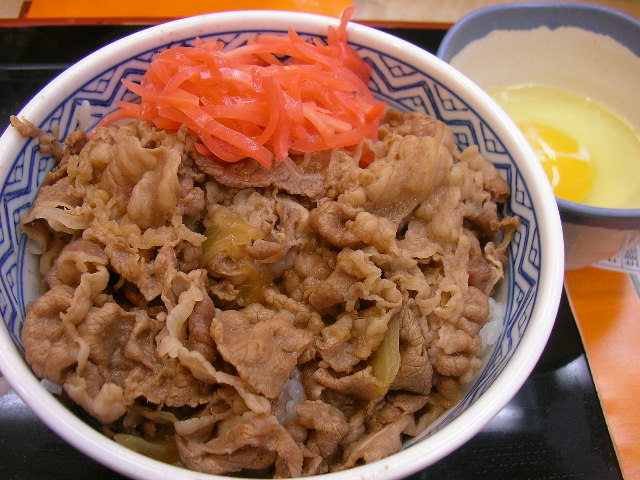|
Unagi
is the Japanese word for freshwater eel, particularly the Japanese eel, . Unagi is a common ingredient in Japanese cooking, often as ''kabayaki''. It is not to be confused with saltwater eel, which is known as ''anago'' in Japanese. In Japanese cuisine Unagi is served as part of ''unadon'' (sometimes spelled ''unagidon'', especially in menus in Japanese restaurants in Western countries), a '' donburi'' dish with sliced eel served on a bed of rice. A kind of sweet biscuit called ''unagi pie'' made with powdered unagi also exists. Unagi is high in protein, vitamin A, and calcium. Specialist unagi restaurants are common in Japan, and commonly have signs showing the word ''unagi'' with hiragana う (transliterated ''u''), which is the first letter of the word ''unagi''. Lake Hamana in Hamamatsu city, Shizuoka prefecture is considered to be the home of the highest quality unagi; as a result, the lake is surrounded by many small restaurants specializing in various unagi dish ... [...More Info...] [...Related Items...] OR: [Wikipedia] [Google] [Baidu] |
Japanese Eel
The Japanese eel (''Anguilla japonica''; Japanese: 日本鰻 ''nihon'unagi'') is a species of anguillid eel found in Japan, Korea, China, and Vietnam, as well as the northern Philippines. There are three main species under the Anguilla genus, and all three share very similar characteristics. These species are so similar that it is believed that they spawned from the same species and then experienced a separation due to different environments in the ocean. Like all the eels of the genus ''Anguilla'' and the family Anguillidae, it is catadromous, meaning it spawns in the sea but lives parts of its life in freshwater. Raised in aquaculture ponds in most countries, the Japanese eel makes up 95% of the commercially sold eel in Japan, the other 5% is shipped over by air to the country from Europe. This food in Japan is called ''unagi''; they are an essential part of the food culture, with many restaurants serving grilled eel called ''kabayaki''. However, presumably due to a combination of ... [...More Info...] [...Related Items...] OR: [Wikipedia] [Google] [Baidu] |
Kabayaki
is a preparation of fish, especially ''unagi'' eel,, vol. 7,"kabayaki" by describes it as being used principally or almost always for ''unagi'' (「もっぱら鰻」) where the fish is split down the back the Japanese dictionary says ''kabayaki'' applies to such fish as ungai, hamo, and dojō (or belly), gutted and boned, butterflied, cut into square fillets, skewered, and dipped in a sweet soy sauce-based marinade before being cooked on a grill or griddle. Besides ''unagi'', the same preparation is made of other long scaleless fish such as ''hamo'' ( pike conger), ''dojō'' (loach), catfish, ''anago'' (conger eel), and ( gunnels). One can also find canned products labeled as kabayaki-style ''sanma'' (Pacific saury). ''Kabayaki'' eel is very popular and a rich source of vitamins A and E, and omega-3 fatty acids., p.144- A popular custom from the Edo period, pp.167-8, repeats a story of an eel purveyor from Edo who asked a calligrapher to write the Ox (day) character as a ... [...More Info...] [...Related Items...] OR: [Wikipedia] [Google] [Baidu] |
Unadon
is a dish originating in Japan. It consists of a '' donburi'' type large bowl filled with steamed white rice, and topped with fillets of eel (''unagi'') grilled in a style known as ''kabayaki'', similar to teriyaki. The fillets are glazed with a sweetened soy-based sauce, called ''tare'' and caramelized, preferably over charcoal fire. The fillets are not flayed, and the grayish skin side is placed faced down., p.63 Sufficient ''tare'' sauce is poured over so that some of it seeps through the rice underneath. By convention, pulverized dried berries of sanshō (called Japanese pepper, although botanically unrelated) are sprinkled on top as seasoning. It is also very popular outside of Japan, particularly in Taiwan and the United States. Variations Variations include ''unajū'' (鰻重, the same dish served in ''jūbako'' (重箱), food boxes often lacquered), ''nagayaki'' (長焼き, the eel and rice are served separately), and ''hitsumabushi'' (ひつまぶし). There are two s ... [...More Info...] [...Related Items...] OR: [Wikipedia] [Google] [Baidu] |
Sushi
is a Japanese cuisine, Japanese dish of prepared , usually with some sugar and salt, accompanied by a variety of , such as seafood, often raw, and vegetables. Styles of sushi and its presentation vary widely, but the one key ingredient is "sushi rice," also referred to as , or . The inventor of modern sushi is believed to be Hanaya Yohei, who invented nigiri-zushi, a type of sushi most known today, in which seafood is placed on hand-pressed vinegared rice, around 1824 in the Edo period (1603–1867). It was the fast food of the ''chōnin'' class in the Edo period. Sushi is traditionally made with white rice, medium-grain white rice, though it can be prepared with brown rice or Short grain rice, short-grain rice. It is very often prepared with seafood, such as Squid as food, squid, eel, Japanese amberjack, yellowtail, salmon, tuna or Crab stick, imitation crab meat. Many types of sushi are Vegetarian cuisine, vegetarian. It is often served with , wasabi, and soy sauce. Daiko ... [...More Info...] [...Related Items...] OR: [Wikipedia] [Google] [Baidu] |
Anago
is the Japanese word for salt-water eels, normally referring to ma-anago (''Conger myriaster''). Ma-anago are used for a seafood dish in Japan. They are often simmered (sushi) or deep-fried (tempura), compared to unagi (freshwater eels) which are usually barbecued with a sauce (kabayaki). Anago is also slightly less rich and oily than unagi. Anago has a very soft texture and sweet taste. Species * ''Heteroconger hassi'' (Klausewitz & Eibl-Eibesfeldt 1959) * ''Ariosoma anago'', ''Anago anago'' or ''Conger anago'' (Temminck et Schlegel, 1846) * ''Conger cinereus'' (Rüppell, 1830) * ''Conger japonicus'' (Bleeker, 1879) * ''Conger myriaster'' (Brevoort, 1856) * ''Gorgasia japonica ''Gorgasia'' is one of the two genera that belong to the subfamily '' Heterocongrinae'' (common name: garden eels). This genus is classified by the behavioral pattern of burrowing 75% of their bodies in the sandy substrate they live in and protru ...'' (Abe, Asai & Miki 1977) References {{seafoo ... [...More Info...] [...Related Items...] OR: [Wikipedia] [Google] [Baidu] |
Donburi
is a Japanese "rice-bowl dish" consisting of fish, meat, vegetables or other ingredients simmered together and served over rice. ''Donburi'' meals are usually served in oversized rice bowls which are also called ''donburi''. If one needs to distinguish, the bowl is called and the food is called . The simmering sauce varies according to season, ingredients, region, and taste. A typical sauce might consist of ''dashi'' (stock broth) flavored with soy sauce and ''mirin'' (rice wine). Proportions vary, but there is normally three to four times as much ''dashi'' as soy sauce and ''mirin''. For ''oyakodon'', Tsuji (1980) recommends dashi flavored with light soy sauce, dark soy sauce, and sugar. For ''gyūdon'', Tsuji recommends water flavored with dark soy sauce and ''mirin''. One can make donburi from almost any ingredients, including leftovers. Varieties of donburi Traditional Japanese ''donburi'' include the following: ''Gyūdon'' , is a Japanese dish consisting of a bowl ... [...More Info...] [...Related Items...] OR: [Wikipedia] [Google] [Baidu] |
Carnivore
A carnivore , or meat-eater (Latin, ''caro'', genitive ''carnis'', meaning meat or "flesh" and ''vorare'' meaning "to devour"), is an animal or plant whose food and energy requirements derive from animal tissues (mainly muscle, fat and other soft tissues) whether through hunting or scavenging. Nomenclature Mammal order The technical term for mammals in the order Carnivora is ''carnivoran'', and they are so-named because most member species in the group have a carnivorous diet, but the similarity of the name of the order and the name of the diet causes confusion. Many but not all carnivorans are meat eaters; a few, such as the large and small cats (felidae) are ''obligate'' carnivores (see below). Other classes of carnivore are highly variable. The Ursids, for example: While the Arctic polar bear eats meat almost exclusively (more than 90% of its diet is meat), almost all other bear species are omnivorous, and one species, the giant panda, is nearly exclusively herbivorous. ... [...More Info...] [...Related Items...] OR: [Wikipedia] [Google] [Baidu] |
Parasite
Parasitism is a close relationship between species, where one organism, the parasite, lives on or inside another organism, the host, causing it some harm, and is adapted structurally to this way of life. The entomologist E. O. Wilson has characterised parasites as "predators that eat prey in units of less than one". Parasites include single-celled protozoans such as the agents of malaria, sleeping sickness, and amoebic dysentery; animals such as hookworms, lice, mosquitoes, and vampire bats; fungi such as Armillaria mellea, honey fungus and the agents of ringworm; and plants such as mistletoe, dodder, and the Orobanchaceae, broomrapes. There are six major parasitic Behavioral ecology#Evolutionarily stable strategy, strategies of exploitation of animal hosts, namely parasitic castration, directly transmitted parasitism (by contact), wikt:trophic, trophicallytransmitted parasitism (by being eaten), Disease vector, vector-transmitted parasitism, parasitoidism, and micropreda ... [...More Info...] [...Related Items...] OR: [Wikipedia] [Google] [Baidu] |
Captive Breeding
Captive breeding, also known as captive propagation, is the process of plants or animals in controlled environments, such as wildlife reserves, zoos, botanic gardens, and other conservation facilities. It is sometimes employed to help species that are being threatened by the effects of human activities such as climate change, habitat loss, fragmentation, over hunting or fishing, pollution, predation, disease, and parasitism. For many species, relatively little is known about the conditions needed for successful breeding. Information about a species' reproductive biology may be critical to the success of a captive breeding program. In some cases a captive breeding program can save a species from extinction, but for success, breeders must consider many factors—including genetic, ecological, behavioral, and ethical issues. Most successful attempts involve the cooperation and coordination of many institutions. History Captive breeding techniques began with the first human do ... [...More Info...] [...Related Items...] OR: [Wikipedia] [Google] [Baidu] |
Fish Farming
upright=1.3, Salmon farming in the sea (mariculture) at Loch Ainort, Isle of Skye">mariculture.html" ;"title="Salmon farming in the sea (mariculture">Salmon farming in the sea (mariculture) at Loch Ainort, Isle of Skye, Scotland Fish farming or pisciculture involves commercial animal husbandry, breeding of fish, usually for food, in fish tanks or artificial pen (enclosure), enclosures such as fish ponds. It is a particular type of aquaculture, which is the controlled cultivation and harvesting of aquatic animals such as fish, crustaceans, molluscs and so on, in natural or pseudo-natural environment. A facility that releases juvenile fish into the wild for recreational fishing or to supplement a species' natural numbers is generally referred to as a fish hatchery. Worldwide, the most important fish species produced in fish farming are carp, catfish, salmon and tilapia. Global demand is increasing for dietary fish protein, which has resulted in widespread overfishing in wild ... [...More Info...] [...Related Items...] OR: [Wikipedia] [Google] [Baidu] |
European Eel
The European eel (''Anguilla anguilla'') is a species of eel, a snake-like, catadromous fish. They are normally around and rarely reach more than , but can reach a length of up to in exceptional cases. Eels have been important sources of food both as adults (including jellied eels of East London) and as glass eels. Glass-eel fishing using basket traps has been of significant economic value in many river estuaries on the western seaboard of Europe. While the species' lifespan in the wild has not been determined, captive specimens have lived over 80 years. A specimen known as "the Brantevik Eel" lived for 155 years in the well of a family home in Brantevik, a fishing village in southern Sweden. Conservation status The European eel is a critically endangered species. Since the 1970s, the numbers of eels reaching Europe is thought to have declined by around 90% (possibly even 98%). Contributing factors include overfishing, parasites such as ''Anguillicola crassus'', bar ... [...More Info...] [...Related Items...] OR: [Wikipedia] [Google] [Baidu] |






